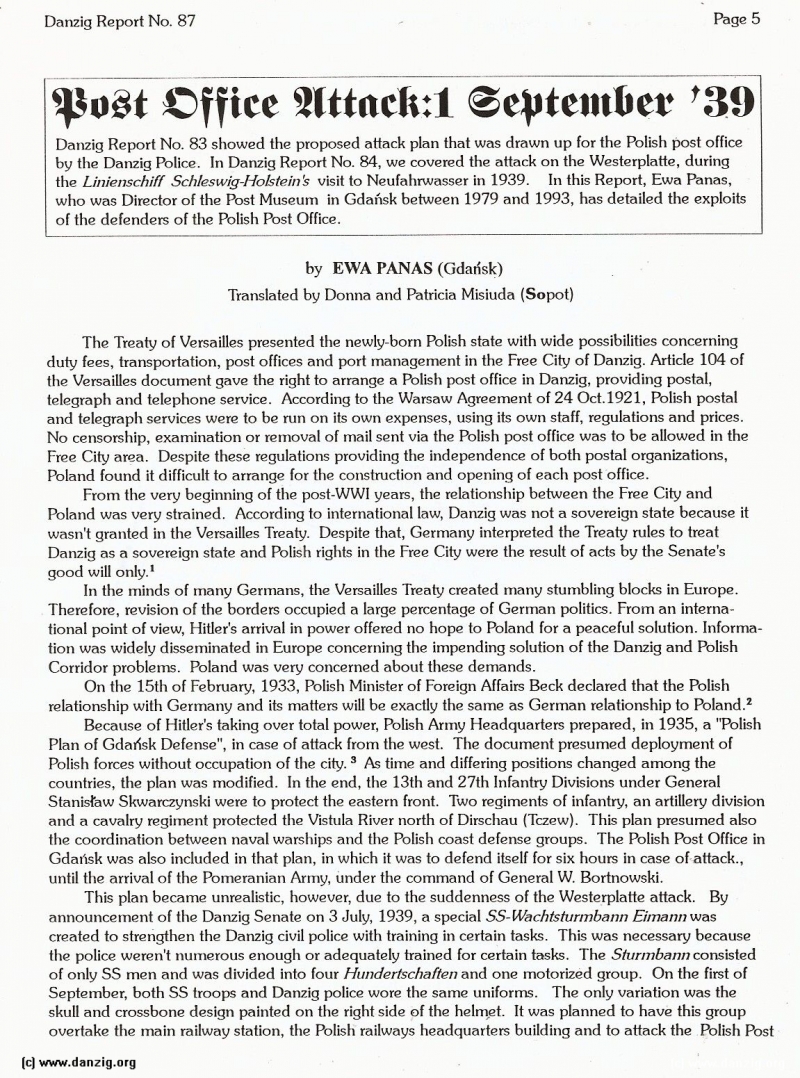
Post office attack, 1 September '39
By Ewa Panas.
The Treaty of Versailles presented the newly-born Polish state with wide possibilities concerning duty fees, transportation, post offices and port management in the Free City of Danzig. Article 104 of the Versailles document gave the right to arrange a Polish post office in Danzig, providing postal, telegraph and telephone service. According to the Warsaw Agreement of 24 October 1921, Polish postal and telegraph services were to be run on its own expenses, using its own staff, regulations and prices. No censorship, examination or removal of mail sent via the Polish post office was to be allowed in the Free City area. Despite these regulations providing the independence of both postal organizations, Poland found it difficult to arrange for the construction and opening of each post office.
From the very beginning of the post-WW I years, the relationship between the Free City and Poland was very strained. According to internationaL Law, Danzig was not a sovereign state because it wasn’t granted in the Versailles Treaty. Despite that, Germany interpreted the Treaty rules to treat Danzig as a sovereign state and Polish rights in the Free City were the result of acts by the Senate’s good will only.
In the minds of many Germans, the Versailles Treaty created many stumbling blocks in Europe. Therefore, revision of the borders occupied a large percentage of German politics. From an international point of view, Hitler’s arrival in power offered no hope to Poland for a peaceful solution. Information was widely disseminated in Europe concerning the impending solution of the Danzig and Polish Corridor problems. Poland was very concerned about these demands.
On the 15th of February, 1933, Polish Minister of Foreign Affairs Beck declared that the Polish relationship with Germany and its matters will be exactly the same as German relationship to Poland.
Because of Hitler’s taking over total power, Polish Army Headquarters prepared, in 1935, a “Polish Plan of Gdansk Defense”, in case of attack from the west. The document presumed deployment of Polish forces without occupation of the city. As time and differing positions changed among the countries, the plan was modified. In the end, the 13th and 27th Infantry Divisions under General Stanistaw Skwarczynski were to protect the eastern front. Two regiments of infantry, an artillery division and a cavalry regiment protected the Visttila River north of Dirschau (Tczew). This plan presumed also the coordination between naval warships and the Polish coast defense groups. The Polish Post Office in Gdansk was also included in that plan, in which it was to defend itself for six hours in case of attack., until the arrival of the Porneranian Army, under the command of General W. Bortnowski.
This plan became unrealistic, however, due to the suddenness of the Westerplatte attack. By announcement of the Danzig Senate on 3 July, 1939, a special SS-Wachtsturimbann Eimann was created to strengthen the Danzig civil police with training in certain tasks. This was necessary because the police weren’t numerous enough or adequately trained for certain tasks. The Sturmbann consisted of only SS men and was divided into four Hundertschaften and one motorized group. On the first of September, both SS troops and Danzig police wore the same uniforms. The only variation was the skull and crossbone design painted on the right side of the helmet. It was planned to have this group overtake the main railway station, the Polish railways headquarters building and to attack the Polish Post.
Danzig Report Nr. 87 - April - May - June - 1995, Page 5.
Hits: 4370
Added: 11/07/2015
Copyright: 2025 Danzig.org

